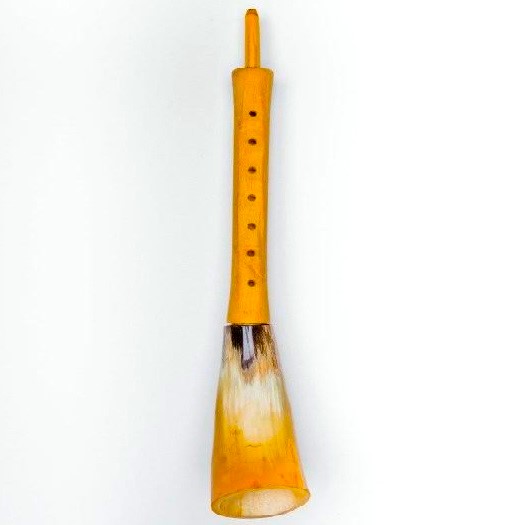Stock-and-horn
Woodwinds
Europe
Between 1001 and 1900 AD
Video
The stock-and-horn is a fascinating and somewhat obscure musical instrument that has roots in the pastoral traditions of Scotland.
Description and Purpose
The stock-and-horn is a traditional wind instrument that consists of two primary components: the stock and the horn. The stock is typically made from the thigh bone of a sheep (often referred to as a “stock”), while the horn is crafted from an animal horn, usually from a goat or sheep. The combination of these materials gives the instrument its unique appearance and sound.The stock serves as the body of the instrument, providing a chamber for air to resonate. The horn acts as the mouthpiece and bell, where sound emerges. The stock-and-horn is characterized by its simple yet effective design, which allows for a range of musical expressions.The primary purpose of the stock-and-horn is to produce music in pastoral settings. Historically, it was used by shepherds and rural communities for various functions, including signaling, entertainment, and social gatherings. The instrument’s sound is often described as haunting and melodic, making it suitable for folk music and traditional dances.
History and Origin
The origins of the stock-and-horn can be traced back to 18th-century Scotland, where it emerged as part of the pastoral lifestyle. It shares similarities with other traditional instruments such as the English hornpipe and the Welsh pibcorn. The stock-and-horn reflects the cultural heritage of rural Scotland, where music played a vital role in community life. Historical records suggest that the stock-and-horn was commonly used by shepherds to communicate across vast distances in hilly terrains. Its unique sound could carry over long distances, making it an effective tool for signaling between herders or calling livestock. As with many traditional instruments, the stock-and-horn faced challenges with modernization. With advancements in musical technology and changes in lifestyle, its popularity declined throughout the 19th century. However, efforts have been made to revive interest in this unique instrument as part of Scotland’s cultural heritage.
Working Mechanism
The working mechanism of the stock-and-horn is relatively straightforward but requires skill and practice to master. The player blows air into the horn while covering specific holes along the body (stock) to create different pitches and tones.
Sound Production: When air is blown into the horn, it creates vibrations within the chamber formed by the stock. The shape and size of both components influence how sound resonates and projects.
Pitch Variation: Players can change pitches by covering or uncovering holes along the stock with their fingers. This technique allows for a range of notes to be produced, similar to other woodwind instruments.
Articulation: The player can control dynamics (loudness or softness) by varying their breath pressure while playing. This control allows for expressive performances that convey emotion through music.
Tuning: Like many traditional instruments, tuning can be influenced by environmental factors such as temperature or humidity. Players may need to adjust their technique based on these conditions.
Types of Stock-and-Horns
While there are variations in design based on regional practices or personal preferences, stock-and-horns generally fall into two main categories:
- Traditional Stock-and-Horn: This version adheres closely to historical designs using natural materials like sheep bones and animal horns. It reflects authentic craftsmanship passed down through generations.
- Modern Adaptations: Some contemporary makers have created variations using synthetic materials or altered designs for improved playability or durability. These adaptations aim to make the instrument more accessible while preserving its essential characteristics.
Features of Stock-and-Horns
The Stock-and-Horns is a traditional wind instrument consisting of animal horns, typically from cows, goats, or rams, attached to a wooden stock or handle. This simple yet distinctive instrument produces a deep, resonant sound, ranging from low rumbles to sharp blasts, depending on the size and number of horns used.
The horns are often naturally curved and affixed to the wooden stock, which serves both as a mouthpiece and a support for the instrument. The Stock-and-Horns was historically used in rural settings for signaling, communication over long distances, and during ceremonies or festivals. Its robust tone made it ideal for calling cattle, announcing events, or as part of a rustic ensemble. Though it is less commonly used today, the instrument remains an important symbol of agricultural and pastoral traditions, evoking the cultural heritage of European folk music.
FAQ
What is the Stock-and-Horn and how does it produce sound?
The Stock-and-Horn is an early woodwind instrument that generates sound through a double-reed mechanism. Air blown through the reed vibrates and travels through the instrument’s body, producing sound. The instrument's conical shape and finger holes allow the player to adjust the pitch.
What was the historical significance of the Stock-and-Horn?
The Stock-and-Horn was a popular instrument in early European music, especially during the Renaissance and Baroque periods. It was used in both secular and ceremonial contexts, often serving as an accompaniment for processions, dances, and theatrical performances.
How has the design of the Stock-and-Horn evolved over time?
Over time, the Stock-and-Horn has undergone modifications in construction materials and shape. Initially made from wood and animal horn, later versions included metal components to improve durability and sound quality. The evolution led to the development of other woodwind instruments, such as the bassoon.
 Links
Links
References
Other Instrument
Categories


















